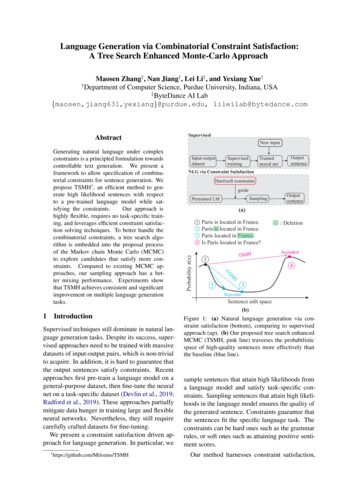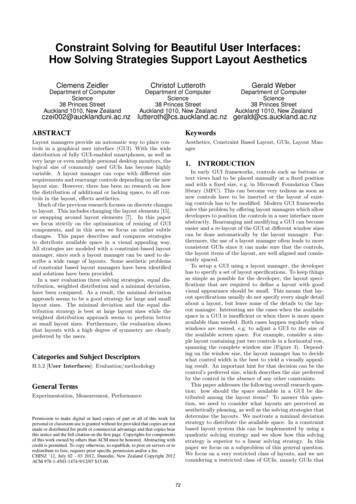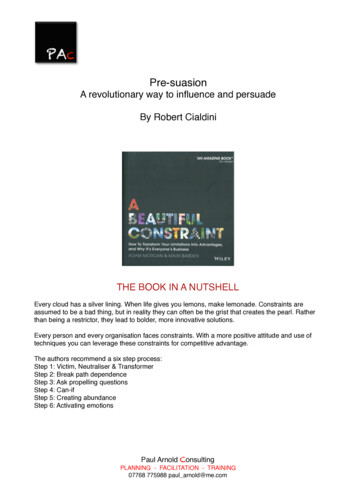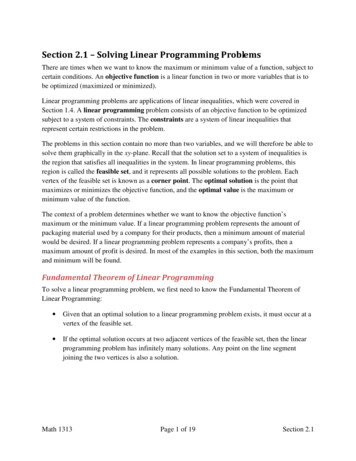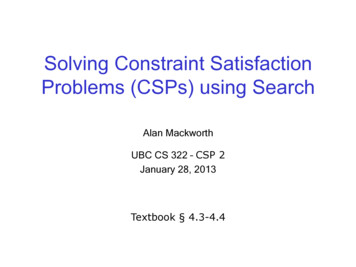
Transcription
Solving Constraint SatisfactionProblems (CSPs) using SearchAlan MackworthUBC CS 322 – CSP 2January 28, 2013Textbook § 4.3-4.4
Lecture Overview Constraint Satisfaction Problems (CSPs):Definition and Recap CSPs: Motivation Solving CSPs- Generate & Test- Graph search2
Course OverviewCourse ModuleEnvironmentProblem n Variables SearchConstraintsLogicSequentialPlanningNow focuson iminationMarkov ProcessesValueIterationDecisionTheory3
Standard Search vs. CSP First studied general state space search in isolation– Standard search problem: search in a state space State is a “black box” - any arbitrary data structure thatsupports three problem-specific routines:– goal test: goal(state)– finding successor nodes: neighbors(state)– if applicable, heuristic evaluation function: h(state) We’ll see more specialized versions of search for variousproblems4
Search in Specific R&R Systems Constraint Satisfaction Problems:––––– Planning :––––– StateSuccessor functionGoal testSolutionHeuristic functionStateSuccessor functionGoal testSolutionHeuristic functionInference–––––StateSuccessor functionGoal testSolutionHeuristic function
Constraint Satisfaction Problems (CSPs): DefinitionDefinition:A constraint satisfaction problem (CSP) consists of: a set of variables V a domain dom(V) for each variable V V a set of constraints CSimple example: V {V1}Another example: V {V1,V2}– dom(V1) {1,2,3}– dom(V2) {1,2}– dom(V1) {1,2,3,4} C {C1,C2}– C1: V1 2– C2: V1 1 C {C1,C2,C3}– C1: V2 2– C2: V1 V2 5– C3: V1 V26
Constraint Satisfaction Problems (CSPs): DefinitionDefinition:A constraint satisfaction problem (CSP) consists of: a set of variables V a domain dom(V) for each variable V V a set of constraints CDefinition:A model of a CSP is an assignment of values to all ofits variables that satisfies all of its constraints.Simple example: V {V1} All models for this CSP:– dom(V1) {1,2,3,4}{V1 3}C {C1,C2}{V1 4}– C1: V1 2– C2: V1 17
Constraint Satisfaction Problems (CSPs): DefinitionDefinition:A constraint satisfaction problem (CSP) consists of: a set of variables V a domain dom(V) for each variable V V a set of constraints CDefinition:A model of a CSP is an assignment of values to all ofits variables that satisfies all of its constraints.Another example: V {V1,V2}– dom(V1) {1,2,3}– dom(V2) {1,2} C {C1,C2,C3}– C1: V2 2– C2: V1 V2 5– C3: V1 V2Which are models for this CSP?{V1 1, V2 1}{V1 2, V2 1}{V1 3, V2 1}{V1 3, V2 2}8
Possible WorldsDefinition:A possible world of a CSP is an assignment ofvalues to all of its variables.Definition:A model of a CSP is an assignment of values to all ofits variables that satisfies all of its constraints.i.e. a model is a possible world that satisfies all constraintsAnother example: V {V1,V2}– dom(V1) {1,2,3}– dom(V2) {1,2} C {C1,C2,C3}– C1: V2 2– C2: V1 V2 5– C3: V1 V2Possible worlds for this CSP:{V1 1,{V1 1,{V1 2,{V1 2,{V1 3,V2 1}V2 2}V2 1} (a model)V2 2}V2 1} (a model){V1 3, V2 2}9
Constraints Constraints are restrictions on the values that one or morevariables can take– Unary constraint: restriction involving a single variable E.g.: V2 2– k-ary constraint: restriction involving k different variables E.g. binary (k 2): V1 V2 5 E.g. 3-ary: V1 V2 V4 5 We will mostly deal with binary constraints– Constraints can be specified by1. listing all combinations of valid domain values for the variablesparticipating in the constraintVV–E.g. for constraint V1 V2and dom(V1) {1,2,3} anddom(V2) {1,2}:122131322. giving a function (predicate) that returns true if given valuesfor each variable which satisfy the constraint else false: V1 V210
Constraints– Constraints can be specified by1. listing all combinations of valid domain values for the variablesparticipating in the constraintVV–E.g. for constraint V1 V2and dom(V1) {1,2,3} anddom(V2) {1,2}:122131322. giving a function that returns true when given valuesfor each variable which satisfy the constraint: V1 V2 A possible world satisfies a set of constraints– if the values for the variables involved in each constraint areconsistent with that constraint1. They are elements of the list of valid domain values2. Function returns true for those values– Examples {V1 1, V2 1} (does not satisfy above constraint){V1 3, V2 1} (satisfies above constraint)11
Scope of a constraintDefinition:The scope of a constraint is the set of variables thatare involved in the constraint Examples:– V2 2 has scope {V2}– V1 V2 has scope {V1,V2}– V1 V2 V4 5 has scope {V1,V2,V4} How many variables are in the scope of a k-ary constraint ?k variables12
Finite Constraint SatisfactionProblem: DefinitionDefinition:A finite constraint satisfaction problem (FCSP) is a CSPwith a finite set of variables and a finite domain foreach variable.We will only study finite CSPs here but many of thetechniques carry over to countably infinite and continuousdomains. We use CSP here to refer to FCSP.The scope of each constraint is automatically finite since itis a subset of the finite set of variables.13
Examples: variables, domains, constraints Crossword Puzzle:– variables are words that have to be filled in– domains are English words of correct length– (binary) constraints: words have the sameletters at cells where they intersect Crossword 2:– variables are cells (individual squares)– domains are letters of the alphabet– k-ary constraints: sequences of letters form valid English words(k 2,3,4,5,6,7,8,9)14
Examples: variables, domains, constraints Sudoku– variables are cells– domain of each variable is {1,2,3,4,5,6,7,8,9}– constraints: rows, columns, boxes contain all different numbers How many possible worlds are there? (say, 53 empty cells)53*9539953 How many models are there in a typical Sudoku?About 253195315
Examples: variables, domains, constraints Scheduling Problem:– variables are different tasks that need to be scheduled(e.g., course in a university; job in a machine shop)– domains are the different combinations of times and locations foreach task (e.g., time/room for course; time/machine for job)– constraints: tasks can't be scheduled in the same location at thesame time; certain tasks can't be scheduled in different locations atthe same time; some tasks must come earlier than others; etc. n-Queens problem– variable: location of a queen on a chess board there are n of them in total, hence the name– domains: grid coordinates– constraints: no queen can attack another16
Constraint Satisfaction Problems: Variants We may want to solve the following problems with a CSP:–––––determine whether or not a model existsfind a modelfind all of the modelscount the number of modelsfind the best model, given some measure of model quality this is now an optimization problem– determine whether some property of the variables holds in allmodels17
Solving Constraint Satisfaction Problems Even the simplest problem of determining whether or not amodel exists in a general CSP with finite domains is NPhard– There is no known algorithm with worst case polynomial runtime.– We can't hope to find an algorithm that is polynomial for all CSPs. However, we can try to:– find efficient (polynomial) consistency algorithms that reduce thesize of the search space– identify special cases for which algorithms are efficient– work on approximation algorithms that can find good solutionsquickly, even though they may offer no theoretical guarantees– find algorithms that are fast on typical (not worst case) cases18
Lecture Overview Constraint Satisfaction Problems (CSPs):Definition and Recap Constraint Satisfaction Problems (CSPs): Motivation Solving Constraint Satisfaction Problems (CSPs)- Generate & Test- Graph search19
CSP/logic: formal verificationHardware verificationSoftware verification(e.g., IBM)(small to medium programs)Most progress in the last 10 years based on:Encodings into propositional satisfiability (SAT)20
The Propositional Satisfiability Problem (SAT) Formula in propositional logic– i.e. it only contains propositional (Boolean) variables– Shorthand notation: x for X true, and x for X false– Literal: x, x In so-called conjunctive normal form (CNF)– Conjunction of clauses (disjunctions of literals)– E.g., F (x1 x2 x3) ( x1 x2 x3) ( x1 x2 x3)– Let’s write F as a CSP: 3 variables: X1, X2, X3 Domains: for all variables {true, false} Constraints (clauses):(x1 x2 x3)( x1 x2 x3)( x1 x2 x3) One of the models: X1 true, X2 false, X3 true21
Importance of SAT Similar problems as in CSPs– Decide whether F has a model– Find a model of F First problem shown to be NP-hard problem (3-SAT)– One of the most important problems in theoretical computerscience Is there an efficient (i.e. worst-case polynomial) algorithm for SAT?– I.e., is NP P? SAT is a deceptively simple problem! Important in practice: encodings of formal verificationproblems– Software verification: finding bugs in Windows etc.– Hardware verification: verify computer chips (IBM, Intel big players)22
SAT Solvers Building algorithms and software that perform well inpractice– On the type of instances they face Software and hardware verification instances 100,000s of variables, millions of constraints Runtime: seconds!– But: there are classes of instances where current algorithms fail International SAT competition (http://www.satcompetition.org/)– About 40 solvers from around the world compete, bi-yearly– Best solver in 2007 and 2009:SATzilla: a SAT solver monster(combines many other SAT solvers)Lin Xu, Frank Hutter, Holger Hoos, and Kevin Leyton-Brown(all from UBC)23
Lecture Overview Constraint Satisfaction Problems (CSPs):Definition and Recap Constraint Satisfaction Problems (CSPs): Motivation Solving Constraint Satisfaction Problems (CSPs)- Generate & Test- Graph search24
Generate and Test (GT) Algorithms Systematically check all possible worlds- Possible worlds: cross product of domainsdom(V1) dom(V2) . dom(Vn) Generate and Test:- Generate possible worlds one at a time- Test constraints for each one.Example: 3 variables A,B,CFor a in dom(A)For b in dom(B)For c in dom(C)if {A a, B b, C c} satisfies all constraintsreturn {A a, B b, C c}fail
Generate and Test (GT) Algorithms If there are k variables, each with domain size d, andthere are c constraints, the complexity of Generate &Test isO(ckd)-O(ckd)O(cdk)O(dck)There are dk possible worldsFor each one need to check c constraints26
Lecture Overview Constraint Satisfaction Problems (CSPs):Definition and Recap Constraint Satisfaction Problems (CSPs): Motivation Solving Constraint Satisfaction Problems (CSPs)- Generate & Test- Graph search27
CSP as a Search Problem: one formulation States: partial assignment of values to variables Start state: empty assignment Successor function: states with the next variable assigned– E.g., follow a total order of the variables V1, , Vn– A state assigns values to the first k variables: {V1 v1, ,Vk vk } Neighbors of node {V1 v1, ,Vk vk }:nodes {V1 v1, ,Vk vk, Vk 1 x} for each x dom(Vk 1) Goal state: complete assignments of values to variablesthat satisfy all constraints– That is, models Solution: assignment (the path doesn’t matter)28
CSP as Graph Searching{}V1 v1V1 v1V2 v1V1 v1V2 v1V3 v1V1 v1V2 v1V3 v2V1 v1V2 v2V1 vkV1 v1V2 vk
Which search algorithm would be mostappropriate for this formulation of CSP?Depth First SearchLeast Cost First SearchA*None of the above
Relationship To Search The path to a goal isn’t important, only the solution is Heuristic function: “none”- All goals are at the same depth CSP problems can be huge-Thousands of variables -Exponentially more search statesExhaustive search is typically infeasible Many algorithms exploit the structure provided by thegoal set of constraints, *not* black box
Backtracking algorithms Explore search space via DFS but evaluate eachconstraint as soon as all its variables are bound. Any partial assignment that doesn’t satisfy theconstraint can be pruned. Example:- 3 variables A, B, C each with domain {1,2,3,4}- {A 1, B 1} is inconsistent with constraint A Bregardless of the value of the other variables Fail! Prune!
CSP as Graph SearchingCheck unary constraints on V1If not satisfied PRUNE{}V1 v1Check constraints on V1and V2 If not satisfied PRUNEV1 v1V2 v1V1 v1V2 v1V3 v1V1 v1V2 v1V3 v2V1 v1V2 v2V1 vkV1 v1V2 vk
CSP as Graph SearchingCheck unary constraints on V1If not satisfied PRUNE{}V1 v1Check constraints on V1and V2 If not satisfied PRUNEV1 v1V2 v1V1 v1V2 v1V3 v1V1 v1V2 v1V3 v2V1 v1V2 v2V1 vkV1 v1V2 vkProblem?Performance heavily dependson the order in whichvariables are considered.E.g. only 2 constraints:Vn Vn-1 and Vn Vn-1
CSP as a Search Problem: another formulation States: partial assignment of values to variables Start state: empty assignment Successor function: states with the next variable assigned– Assign each previously unassigned variable– A state assigns values to some subset of variables: E.g. {V7 v1, V2 v1, V15 v1} Neighbors of node {V7 v1, V2 v1, V15 v1}:nodes {V7 v1, V2 v1, V15 v1, Vx y}for any variable Vx V \ {V7, V2, V15} and any value y dom(Vx) Goal state: complete assignments of values to variablesthat satisfy all constraints– That is, models Solution: assignment (the path doesn’t matter)35
CSP Solving as Graph Searching 3 Variables: A,B,C. All with domains {1,2,3,4} Constraints: A B, B C
Selecting variables in a smart way Backtracking relies on one or more heuristics to selectwhich variables to consider next.- E.g, variable involved in the largest number of constraints:“If you are going to fail on this branch, fail early!”- Can also be smart about which values to consider first This is a different use of the word ‘heuristic’!- Still true in this context Can be computed cheaply during the search Provides guidance to the search algorithm- But not true anymore in this context ‘Estimate of the distance to the goal’ Both meanings are used frequently in the AI literature. ‘heuristic’ means ‘serves to discover’: goal-oriented. Does not mean ‘unreliable’!37
Standard Search vs. Specific R&R systems Constraint Satisfaction (Problems):––––– Planning :––––– State: assignments of values to a subset of the variablesSuccessor function: assign values to a “free” variableGoal test: all variables assigned a value and all constraints satisfied?Solution: possible world that satisfies the constraintsHeuristic function: none (all solutions at the same distance from start)StateSuccessor functionGoal testSolutionHeuristic functionInference–––––StateSuccessor functionGoal testSolutionHeuristic function
Learning Goals for today’s class Define possible worlds in term of variables and their domains– Compute number of possible worlds on real examples Specify constraints to represent real world problemsdifferentiating between:– Unary and k-ary constraints– List vs. function format Verify whether a possible world satisfies a set of constraints(i.e., whether it is a model, a solution)Implement the Generate-and-Test Algorithm. Explain itsdisadvantages.Solve a CSP by search (specify neighbors, states, start state, goalstate). Compare strategies for CSP search. Implement pruning forDFS search in a CSP.Coming up: Arc consistency and domain splitting– Read Sections 4.5-4.6 Assignment 1 is due this Friday39
Solving Constraint Satisfaction Problems (CSPs) using Search Alan Mackworth UBC CS 322 - CSP 2 January 28, 2013 Textbook § 4.3-4.4
